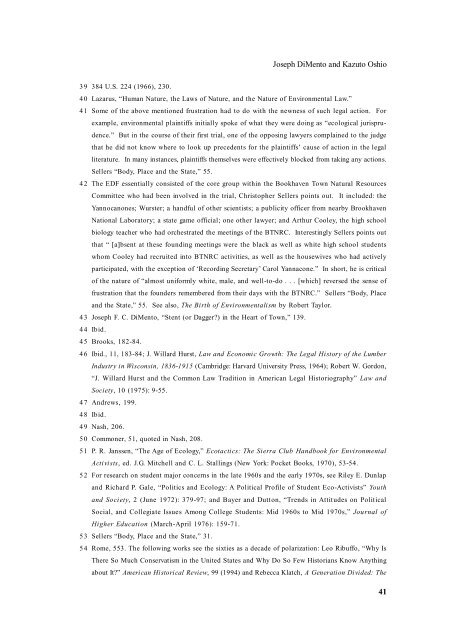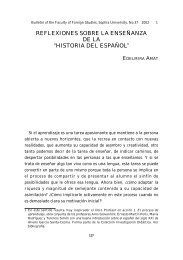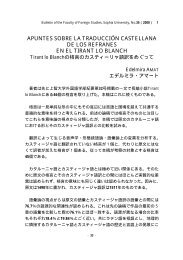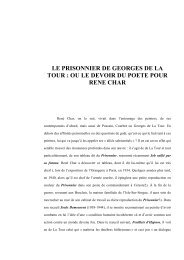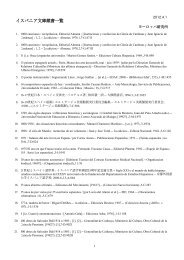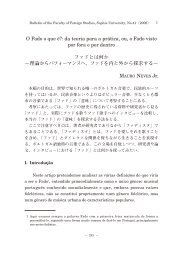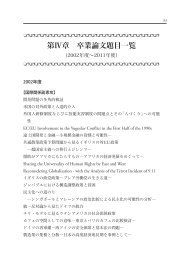Forgotten Paths to NEPA: A Historical Analysis of the Early ...
Forgotten Paths to NEPA: A Historical Analysis of the Early ...
Forgotten Paths to NEPA: A Historical Analysis of the Early ...
Create successful ePaper yourself
Turn your PDF publications into a flip-book with our unique Google optimized e-Paper software.
Joseph DiMen<strong>to</strong> and Kazu<strong>to</strong> Oshio<br />
3 9 384 U.S. 224 (1966), 230.<br />
4 0 Lazarus, “Human Nature, <strong>the</strong> Laws <strong>of</strong> Nature, and <strong>the</strong> Nature <strong>of</strong> Environmental Law.”<br />
4 1 Some <strong>of</strong> <strong>the</strong> above mentioned frustration had <strong>to</strong> do with <strong>the</strong> newness <strong>of</strong> such legal action. For<br />
example, environmental plaintiffs initially spoke <strong>of</strong> what <strong>the</strong>y were doing as “ecological jurisprudence.”<br />
But in <strong>the</strong> course <strong>of</strong> <strong>the</strong>ir first trial, one <strong>of</strong> <strong>the</strong> opposing lawyers complained <strong>to</strong> <strong>the</strong> judge<br />
that he did not know where <strong>to</strong> look up precedents for <strong>the</strong> plaintiffs’ cause <strong>of</strong> action in <strong>the</strong> legal<br />
literature. In many instances, plaintiffs <strong>the</strong>mselves were effectively blocked from taking any actions.<br />
Sellers “Body, Place and <strong>the</strong> State,” 55.<br />
4 2 The EDF essentially consisted <strong>of</strong> <strong>the</strong> core group within <strong>the</strong> Bookhaven Town Natural Resources<br />
Committee who had been involved in <strong>the</strong> trial, Chris<strong>to</strong>pher Sellers points out. It included: <strong>the</strong><br />
Yannocanones; Wurster; a handful <strong>of</strong> o<strong>the</strong>r scientists; a publicity <strong>of</strong>ficer from nearby Brookhaven<br />
National Labora<strong>to</strong>ry; a state game <strong>of</strong>ficial; one o<strong>the</strong>r lawyer; and Arthur Cooley, <strong>the</strong> high school<br />
biology teacher who had orchestrated <strong>the</strong> meetings <strong>of</strong> <strong>the</strong> BTNRC. Interestingly Sellers points out<br />
that “ [a]bsent at <strong>the</strong>se founding meetings were <strong>the</strong> black as well as white high school students<br />
whom Cooley had recruited in<strong>to</strong> BTNRC activities, as well as <strong>the</strong> housewives who had actively<br />
participated, with <strong>the</strong> exception <strong>of</strong> ‘Recording Secretary’ Carol Yannacone.” In short, he is critical<br />
<strong>of</strong> <strong>the</strong> nature <strong>of</strong> “almost uniformly white, male, and well-<strong>to</strong>-do . . . [which] reversed <strong>the</strong> sense <strong>of</strong><br />
frustration that <strong>the</strong> founders remembered from <strong>the</strong>ir days with <strong>the</strong> BTNRC.” Sellers “Body, Place<br />
and <strong>the</strong> State,” 55. See also, The Birth <strong>of</strong> Environmentalism by Robert Taylor.<br />
4 3 Joseph F. C. DiMen<strong>to</strong>, “Stent (or Dagger?) in <strong>the</strong> Heart <strong>of</strong> Town,” 139.<br />
4 4 Ibid.<br />
4 5 Brooks, 182-84.<br />
4 6 Ibid., 11, 183-84; J. Willard Hurst, Law and Economic Growth: The Legal His<strong>to</strong>ry <strong>of</strong> <strong>the</strong> Lumber<br />
Industry in Wisconsin, 1836-1915 (Cambridge: Harvard University Press, 1964); Robert W. Gordon,<br />
“J. Willard Hurst and <strong>the</strong> Common Law Tradition in American Legal His<strong>to</strong>riography” Law and<br />
Society, 10 (1975): 9-55.<br />
4 7 Andrews, 199.<br />
4 8 Ibid.<br />
4 9 Nash, 206.<br />
5 0 Commoner, 51, quoted in Nash, 208.<br />
5 1 P. R. Janssen, “The Age <strong>of</strong> Ecology,” Ecotactics: The Sierra Club Handbook for Environmental<br />
Activists, ed. J.G. Mitchell and C. L. Stallings (New York: Pocket Books, 1970), 53-54.<br />
5 2 For research on student major concerns in <strong>the</strong> late 1960s and <strong>the</strong> early 1970s, see Riley E. Dunlap<br />
and Richard P. Gale, “Politics and Ecology: A Political Pr<strong>of</strong>ile <strong>of</strong> Student Eco-Activists” Youth<br />
and Society, 2 (June 1972): 379-97; and Bayer and Dut<strong>to</strong>n, “Trends in Attitudes on Political<br />
Social, and Collegiate Issues Among College Students: Mid 1960s <strong>to</strong> Mid 1970s,” Journal <strong>of</strong><br />
Higher Education (March-April 1976): 159-71.<br />
5 3 Sellers “Body, Place and <strong>the</strong> State,” 31.<br />
5 4 Rome, 553. The following works see <strong>the</strong> sixties as a decade <strong>of</strong> polarization: Leo Ribuffo, “Why Is<br />
There So Much Conservatism in <strong>the</strong> United States and Why Do So Few His<strong>to</strong>rians Know Anything<br />
about It?” American His<strong>to</strong>rical Review, 99 (1994) and Rebecca Klatch, A Generation Divided: The<br />
41


